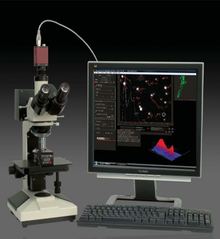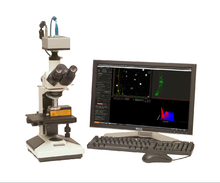- Nanosight
-
NanoSight Ltd. 
Type Limited Industry Nanotechnology Founded 1999 Founder(s) Dr Bob Carr Headquarters Salisbury, United Kingdom Area served International Key people Chairman: John Knowles
CEO: Jeremy Warren
CTO: Dr Bob CarrProducts LM10, LM20, NS500 Website www.nanosight.com NanoSight Ltd, is a company which designs and manufactures Nanoparticle Analysis Instruments. The company was founded in 1999 by Dr. Bob Carr to further develop a technique he invented to visualize nanoparticles suspended in liquid. The company has since developed the technique of Nanoparticle Tracking Analysis (NTA) and they produce a series of instruments to count, size and visualize nanoparticles in liquid suspension using this patented technology.
The company’s current headquarters is in Amesbury, Wiltshire, UK near Salisbury.
Contents
Products
NanoSight develops and produces products to visualize, characterize and measure virtually all nanoparticles. Their products can analyse particle size, concentration, aggregation and zeta potential simultaneously with a fluorescence mode allowing speciation of labeled particles.
The instruments comprise of a scientific camera, microscope[1][2] and an LM12 sample viewing unit and are used in conjunction with a computer control unit which runs the Nanoparticle Tracking Analysis (NTA) software. The LM12 uses a 638 nm red laser diode to illuminate particles in liquid suspension which are held within the unit. NTA is used to analyze videos captured using the instrument, giving a particle size distribution and particle count.
Both the LM10 and the LM20 operate using a custom-designed software package, NTA. This software identifies and tracks individual nanoparticles which are moving under Brownian motion and relates the movement to a particle size. This is carried out for all particles in the laser scattering volume to produce a particle size distribution using the Stokes-Einstein equation, relating the Brownian Motion of a particle to a sphere-equivalent hydrodynamic radius.
Three instruments are currently available;
LM10
NanoSight's LM10 instrument is based upon a conventional optical microscope, fitted with a scientific camera (CCD, EMCCD or sCMOS) and either the LM12 or LM14 viewing unit. Using a laser light source with a wavelength of either 638nm (Red), 405nm (Blue) or 532nm (Green) the particles in the sample are illuminated and the scattered light is captured by the camera and displayed on the connected PC running Nanoparticle Tracking Analysis (NTA).
Using NTA, the particles are automatically tracked and sized. Results are displayed as a frequency size distribution graph and output to a spreadsheet. Additionally, videos clips may be captured an archived for future reference.
The LM10 is proven with most nanoparticle classes down to 10 nm (dependent upon particle type) dispersed in a wide range of solvents:
-
-
- Ceramic and metallic nanoparticles
- Pigments, paints and sun creams
- Pharmaceutical particles - liposomes
- Viruses
- Carbon nanotubes (multi-walled)
- Colloidal suspensions and polymer particles
- Cosmetics and foodstuffs
- Particles in fuels and oils (soot, catalyst, wax etc.)
- Wear debris in lubricants
- Chemical Mechanical Polishing Slurries
- Nanotoxicology studies
-
LM10 Specification:
-
-
- Nanoparticle analysis range: typically 10nm - 1000nm, dependent on particle material
- Particle type: any
- Solvent: any non-corrosive solvent and water. A range of solvent-resistant seals are available.
- Power requirement (own adapter supplied): 110-220V
- Laser output: 40mW at 640nm (Class 1 Laser Product)
- Sample volume requirements: 0.3 ml
-
LM10~HS
NanoSight's LM10-HS instrument is similar to the standard LM10 unit but with the addition of a higher sensitivty sCMOS camera (EMCCD in earlier models). This allows smaller, lower refractive index particles to be analysed.
The LM10-HS is more commonly used for sizing biological samples including viruses and vaccines.
LM20
NanoSight's LM20 is, in essence a 'boxed-up' LM10, designed and created for greater ease of use. Using the same standard LM12 viewing unit as the LM10, this instrument provides identical results to those obtained in analyses run on an LM10 system.
Typically the LM20 is used in more industrious applications such as paints and pigments and cosmetics and foodstuffs. The LM20 is ideal for users not familiar with using a microscope.
LM20 Specification:
-
-
- Nanoparticle analysis range: typically 10nm - 1000nm, dependent on particle material
- Particle type: any
- Solvent: any non-corrosive solvent and water. A range of solvent-resistant seals are available.
- Power requirement (own adapter supplied): 110-220V
- Laser output: 40mW at 640nm (Class 1 Laser Product)
- Sample volume requirements: 500 ml
-
See also
References
- ^ *Bob Carr, Patrick Hole, Andrew Malloy, Jonathan Smith, Andrew Weld and Jeremy Warren (2008) "The real-time, simultaneous analysis of nanoparticle size, zeta potential, count, asymmetry and fluorescence in liquids", Particles 2008; Particle Synthesis, Characterization, and Particle-Based Advanced Materials, 10–13 May 2008, Wyndham Orlando Resort, Orlando, Florida.
- ^ *Warren, J and Carr, R (2007), "Application of Nanoparticle Tracking Analysis to BioNano Systems", 2nd International Congress of Nanobiotechnology & Nanomedicine (NanoBio2007), San Francisco, USA, June 19, 2007.
Links
- New Scientist - on Nanosight
- Nanosight website
Categories:- Microscopy
- Sub-micron microscopy
- Nanotechnology companies
-
Wikimedia Foundation. 2010.



